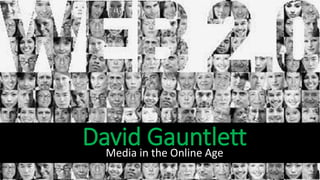Lesson 2 David Gauntlett
•Download as PPTX, PDF•
0 likes•357 views
Lesson 2 David Gauntlett
Report
Share
Report
Share

Recommended
Recommended
More Related Content
What's hot
What's hot (20)
Teaching with Moodle: Engaging Learners through Online Discussions

Teaching with Moodle: Engaging Learners through Online Discussions
Similar to Lesson 2 David Gauntlett
Similar to Lesson 2 David Gauntlett (20)
Social software in education: an early 2007 overview

Social software in education: an early 2007 overview
Social software in education: an early 2007 overview

Social software in education: an early 2007 overview
More from npamediastudies
More from npamediastudies (20)
Recently uploaded
God is a creative God Gen 1:1. All that He created was “good”, could also be translated “beautiful”. God created man in His own image Gen 1:27. Maths helps us discover the beauty that God has created in His world and, in turn, create beautiful designs to serve and enrich the lives of others.
Explore beautiful and ugly buildings. Mathematics helps us create beautiful d...

Explore beautiful and ugly buildings. Mathematics helps us create beautiful d...christianmathematics
Recently uploaded (20)
Explore beautiful and ugly buildings. Mathematics helps us create beautiful d...

Explore beautiful and ugly buildings. Mathematics helps us create beautiful d...
ICT Role in 21st Century Education & its Challenges.pptx

ICT Role in 21st Century Education & its Challenges.pptx
Unit-IV; Professional Sales Representative (PSR).pptx

Unit-IV; Professional Sales Representative (PSR).pptx
Asian American Pacific Islander Month DDSD 2024.pptx

Asian American Pacific Islander Month DDSD 2024.pptx
Unit-V; Pricing (Pharma Marketing Management).pptx

Unit-V; Pricing (Pharma Marketing Management).pptx
On National Teacher Day, meet the 2024-25 Kenan Fellows

On National Teacher Day, meet the 2024-25 Kenan Fellows
Measures of Central Tendency: Mean, Median and Mode

Measures of Central Tendency: Mean, Median and Mode
Basic Civil Engineering first year Notes- Chapter 4 Building.pptx

Basic Civil Engineering first year Notes- Chapter 4 Building.pptx
Web & Social Media Analytics Previous Year Question Paper.pdf

Web & Social Media Analytics Previous Year Question Paper.pdf
Energy Resources. ( B. Pharmacy, 1st Year, Sem-II) Natural Resources

Energy Resources. ( B. Pharmacy, 1st Year, Sem-II) Natural Resources
Lesson 2 David Gauntlett
- 1. David GauntlettMedia in the Online Age
- 2. Web 1.0 vs Web 2.0 • Web 1.0 – No interaction. Information is provided for the user. • Web 2.0 – More collaborative, participatory and creative. Upload, share, download and create. • https://www.youtube.com/watch?v=wj3Maccx81s
- 3. Web 2.0 • “The phrase 'Web 2.0' was coined by Tim O'Reilly. 'Web 2.0' is, as mentioned above, not a replacement for the Web that we know and love, but rather a way of using existing systems in a 'new' way: to bring people together creatively. • The spirit of 'Web 2.0' is that individuals should open themselves to collaborative projects instead of seeking to make and protect their 'own' material. The 'ultimate' example at the moment is perhaps Wikipedia, the massive online encyclopedia created collectively by its millions of visitors. (Other examples include craigslist, del.icio.us, and Flickr).” (David Gauntlett) • Further Reading: http://www.theory.org.uk/mediastudies2.htm
- 4. David Gauntlett - Introduction • Watch the 7 minute video and make notes on what David Gauntlett perceives to be the place of the media in everyday life. • http://www.youtube.com/watch?v=ZWNXg7Vt-ig
- 5. What is Web 2.0? • User-generated material via software and hosted sites – YouTube, MySpace, Facebook – which have been labelled ‘Web 2.0’. • A way of using existing systems in a 'new' way: to bring people together creatively. • The 'ultimate' example at the moment is perhaps Wikipedia, the massive online encyclopaedia created collectively by its millions of visitors. • http://www.youtube.com/watch?v=nF4OBfVQmCI&feature=channel_ page
- 6. How is Web 2.0 really that different? • David Gauntlett argues that people don’t just get represented by the media they use the web 2.0 platforms to make their own media to share with the world and represent themselves. • Media 2.0 is more about people and less about ‘the media’.
- 7. Web 2.0 • More about people less about the media How the internet can transform a person’s life as their video goes viral. • http://www.youtube.com/watch?v=UCOC1YwNwZw • http://www.youtube.com/watch?v=5y3B6jipB90
- 8. Task • What examples can you find that support David Gauntlett’s theory? • Think about examples of creativity and people attempting to change culture (YouTube?) • Participatory culture – Wikipedia? Comments on YouTube? • What about people using the platforms of web 2.0 to represent/expose themselves – Vlogging (video blogs)? • Be prepared to feed your ideas to the rest of the group.
- 9. What do you think? • Charles Leadbeater opens up the debate suggesting how user generated material can be beneficial and also detrimental. • http://www.youtube.com/watch?v=qiP79vYsfbo • Develop a visual representation using examples to both support and challenge his response to the impact of web 2.0? (Gauntlett vs Leadbeater)